At the clap of the audio/video synchronizer we were off and running.
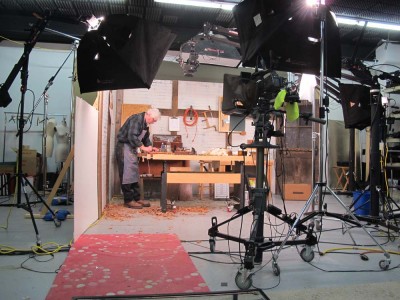
With director David Thiel, videographers Ric and Al behind the cameras we maintained a breakneck pace for two days in filming the video “Historic Transparent Finishes” for the multimedia division of Popular Woodworking. Thanks to their professionalism and some preparations by me we had only two “second takes” in the two days; one of them was to fix a wiggling work bench on the very first segment.
The world of finishing, even transparent finishing, even historic transparent finishing, is simply too big to cover in a single video. My first proposal was for an eight-hour video, which caused David to take a big gulp until he saw that I was actually projecting a two-hour video for a small section of the larger body of material.
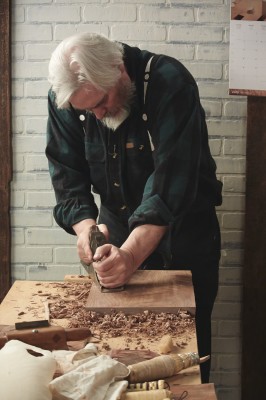
The video is actually a fairly narrow scope as I focused by discussing and demonstrating only wax and shellac finishes over hand planed wood. Starting with rough sawn lumber and finishing with glistening, shimmering, and tactile delights possible with planes, scrapers, polissoirs, brushes, and pads. No oil/resin varnishes, no coloration, no paints, no gilding. Just simple and easy (? straightforward at least).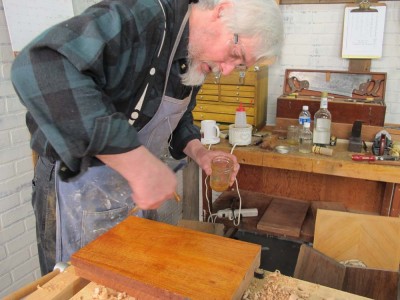
We worked from a detailed outline I had prepared for David, and we did very little out-of-sequence shooting, and then only when it was the only way to get everything done in a timely manner. We were even so efficient that we added three or four vignettes that I had not included in the outline.

One involved the burnishing and varnishing a ball-and-claw leg (thanks Glen Huey for letting me work on one you had laying around) exploring the magic of polished cow horn and filbert mop brushes, which make the finish application so easy it is almost embarrassing. Add an opening, a closing, and some PR snippets and we were done by suppertime of the second day.
As we wrapped up I think it was Ric who said, “Good job. And it was even interesting.” (Did I detect a hint of surprise in his voice?) Of course it was interesting. It was wood finishing!
I was a bit of a zombie the next two days as my wife and I toured Cincinnati and then drove back home to the mountains of the Allegheny Highlands. She says I was just recovering from an adrenalin rush from being “on” for two straight days, and she might be right. I don’t particularly like excitement.
I hope to see a rough cut this week, as Ric said editing it was a piece of cake since the initial work was so clean and linear. I understand the release is sometime around August, so stay tuned. I’m sure it would make a great Christmas gift for your thirty or forty closest friends.
It was more than a week into Spring, and being this Spring the sun rose to reveal an inch of icy snow coating everything the morning we were to visit the incomparable Conner Prairie historic complex, one of the nation’s premier enterprises of historic reenacting and interpretation. Once the slop was scraped from my truck we were on our way; one advantage was that the bitter cold kept the crowd small and we had the place nearly to ourselves.
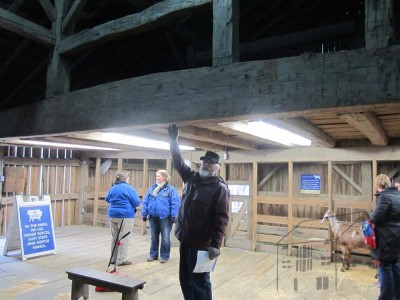
One of the highlights was the timber frame barn in the Conner homestead. The main cross-beam is a gargantuan oak timber more than 12” x 24” x 40 feet long (the historic carpenters there figure the tree trunk was more than eight feet in girth) and the longitudinal mid-rafter beam was an 8×8 perhaps 70 feet long.

I especially enjoyed our time in the carpenter’s shop, where my wife and I were the only visitors. This allowed for a lengthy conversation with the proprietor about tools, wood, and their lathe. He showed it to me and allowed me a turn.

It is a magnificent shop-built machine with a 300-pound flywheel that can get away from you fast! Since I am a head taller than “Mr. McLure” it was very awkward for me, but I could see one of these fitting into the fabric of The Barn.

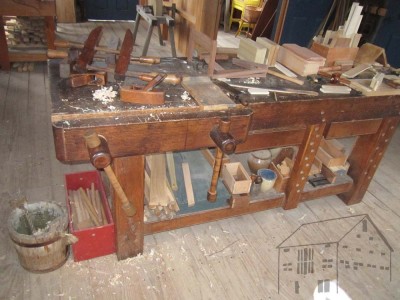
In the center of the one end was the impressive work bench, which had been built in the shop in years past. A copy of no specific documented model, it is instead a combination from a historically accurate vocabulary.
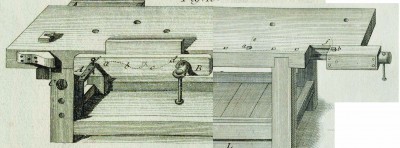
It seems to be about two parts Roubo with one part of Moxon and a dash of Nicholson. The six-inch-square oak legs are capped by a four-inch slab top, and the fixed deadman is stout as well. There is no real woodworker in America who would not be delighted to have this beast in their workspace. I know I would.
If you are going near the Indianapolis area, take a peek.
Recently I spent two days in Cedar Rapids, Iowa, with Team Abraham of Benchcrafted, the brilliant folks who have spawned a revolution in woodworking vises. Father John Abraham and his younger brother Jameel have become some of my favorite people in recent years, and time with them is always a pleasure.

This trip was mostly with Jameel. At one point last year three of the four polymaths I know were with me in the same room; Jameel, Narayan Nayar, and the owner of the Studley Tool Cabinet. My fourth polymath friend is my former colleague Mel Wachowiak at the Smithsonian. I find myself enriched and challenged by each and every interaction with these men.

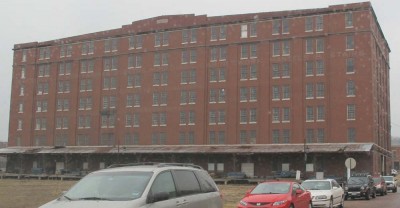
Jameel (and Father John) and I had some business to conduct, some of which you may know about already, and some which will be made known to you in the coming weeks. Part of our time was spent with Jameel squiring me around the countryside to visit a machine shop, a foundry, and a patternmaker. At the final stop he pretty much had to drag me out so we could get back to Cedar Rapids for dinner as the patternmaker and I were swapping tales from the pattern shop. Downtown Dubuque is chock full of vintage factory buildings, especially woodworking factories as the city was once the largest millwork center in the country.

Most of you know Jameel for his exquisite craftsmanship in wood and creative insights. But there is a much deeper presence here. Perhaps the most awe-inspiring moments of the visit were when Jameel showed us his fine art, executed as spiritual devotion for the small chapel currently pastored by Father John, and their dad Father Raphael before him.
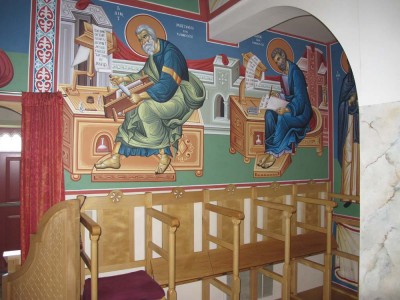
While I am of a dramatically different liturgical tradition, at the foundation we share the same language in our comprehension of the temporal and the eternal.
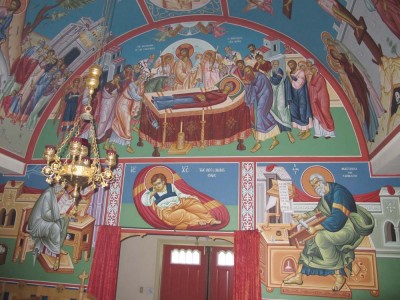
The works speak for themselves, and redound on him favorably in demonstrating the honest piety and Orthodox spiritual worldview of a humble man on whom remarkable gifts have been bestowed.
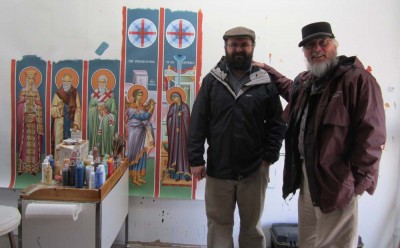
Like I said, he is a polymath.
Since I announced the expansion of the polissoir line about six weeks ago, word has gotten around and stuff’s a-poppin’! It really does help to have enthusiastic support but it is quite a shock to wake up and find your email box stuffed with requests for information about them.
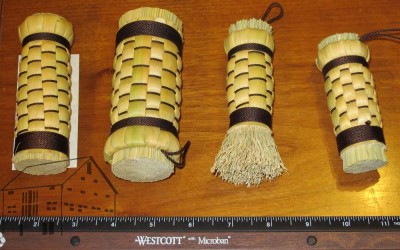
There I was , smoothly sailing along with five or ten orders a week, with a buffer of a month’s inventory at that pace.
WHAM!
In the blink of an eye my inventory was purchased, with multiple quantities in line behind the initial orders. Fortunately I was able to pick up another three dozen last weekend and expect to get another few dozen within a fortnight. I am a bit surprised at the popularity of the large 2″ polissoir, but perhaps I should not be. It gets a lot of spectacular work done in a hurry. I expect to have all the orders filled in about three weeks.
A few things have emerged from this recent chapter.
1. I need to blog about the structure and nature of a good polissoir.
2. I’m thinking about some new polissoir styles to compliment the ones already extant.
3. I need to blog about the properties, technology, and use of natural waxes; beeswax, shellac wax, and carnauba.
4. I need to blog about preparing and tuning up a polissoir.
5. I need to blog about using the polissoir in greater detail, especially how it fits with combined finishing strategies.
Will do.
During my recent trip to the Midwest for a variety of projects, including teaching the Parquetry Workshop for the Kansas City Woodworker’s Guild I was asked to present a public lecture at their facility Friday. At their request, I reflected on the final decade in my career as Senior Furniture Conservator at the nation’s attic. I tend not to obsess about the past, but it was a pleasant reminder of what a wonderful run I had there for almost three decades. It was indeed an honor and privilege to contribute to the longevity of the aggregate cultural memory.
There was no way to include everything I did over a ten year span, but there were a number of projects about which I was especially pleased. Ironically this particular menu included mostly projects for clients outside the Institution. The enthusiastic audience endured my fond reminiscences for almost two hours, then kept me captive with their queries for another hour before we all departed for the evening. The KCWWG guys did seem to appreciate my 14-hour day on their behalf, since I was busy setting up the workshop before 8AM and wrapped up the evening’s festivities just before 10PM. In addition to the giant Chinese picture frame, which I included in the talk, and the Chinese pavilion model, which I did not include, I discussed these projects. This posting is a necessarily brief account, mostly just the “Before” and “After” pictures; you will have to fill in the blanks rom your imagination or listen to me give a similar presentation some time somewhere.
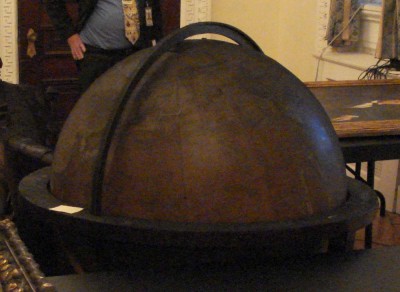
First up was the artifact known as The Roosevelt Globe as it was Teddy Roosevelt’s when he was in Washington. It currently reside sin the ceremonial Office of The Vice President. The globe has suffered spoke damage during the fire at the Old Executive Office Building just before Christmas 2007. The request for my services came directly from the Office of the Vice President of the United States (yes, my “client” was Dick Cheney, although i did not deal with him directly), not normally in my chain of reporting but our government relations office thought it would be a good idea for me to say “Yes.”
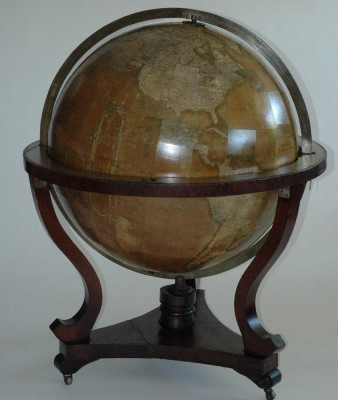
Here is a picture of the globe after I finished conserving it.

Next up was a cabinet by the French-born 19th century New York cabinetmaker Alexander Roux. A gift to a Smithsonian museum, it needed a new base fabricated to reflect the original base — the original base had rotted off and been replaced poorly — so the project included high-level woodworking and also designing and fabricating new bronze mounts that I cast in my home foundry.

This is the cabinet now on display in Washington DC.

A project prototype was the design and construction of minimally intrusive upholstery for this Victorian frame, which clearly needed a little TLC.
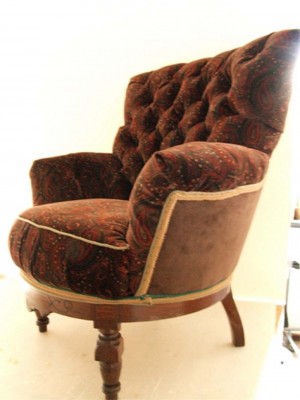
In the end we achieved a fully functional but also fully removable upholstery treatment that is a feast for the eyes and benign for the frame. I hope to post the article about this one in the “Writings” section soon.
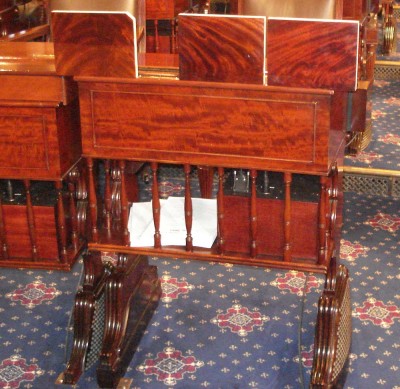
Another interesting project for a non-Institutional client was the finishing of a replica of the Daniel Webster Desk in the US Senate. Here is the original on the floor of the Senate, festooned with several of my sample-color panels.

The Senate cabinet shop built a remarkable copy of this desk, but requested the Senate Majority Leader to invite me to execute the finishing of it. I accepted in the invitation. and here is the result.
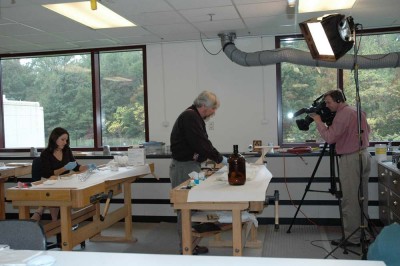
The final project I presented was conserving The Mace of the House of Representatives. Next time you watch C-SPAN note it on the left side of the television screen. Once again my client was extra-institutional, in this case The Speaker of the House. C-SPAN made a segment for a documentary (the segment is in the second part), so everything was under the scrutiny of the camera.

After it was finished, I was photographed with it (as was my entire family) and I had the opportunity to shake the hand of The Speaker. It’s pretty hard to top that one.
Like I said, it was a pretty remarkable three-decade-long run.
This past weekend was the second of the two weekends for the annual Highland Maple Festival in remote and sparsely populated Highland County, Virginia. I was especially delighted that my long time friend and woodworking pal TomS was going to join us for the weekend, demonstrating traditional woodworking in David Blanchard’s Main Street shop in Monterey, VA.
Sunrise on Saturday was not auspicious beginning to the day as the weather was gloomy and cold, and the wind was howling as it had been doing for the previous several days. Temps in the 20s and 30s are not a problem for a tourism-based event, but when coupled with winds that were in the 30-50 mph range, things were not looking favorable for the day. And then there were the increasingly alarming weather reports, which had originally been for a chance of showers through the weekend and increasing morphed into a major snowstorm potential.

As I had feared my shoulder was still too sore to work on the full-sized door I had started the preceding weekend. I could do some work, but I had to keep my hands in close to my torso; the arm extension/power I needed to work on the door was simply not there. Instead I took the opportunity to make a new drawer for my re-cycled tool box, which started life as a case for a surveyor’s transit. I bought it for a buck at a flea market, and since it was made of solid old mahogany I decided to make it something more useful than simply a storage container. Over time it is slowly evolving into a tightly fitted housing for tools, a conceptual distant and poor cousin of Henry Studley’s tool ensemble.
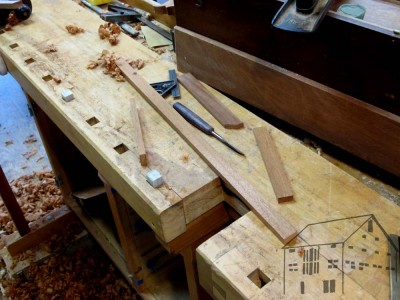
In addition to the original box I added a pair of drawers underneath it, and had already built the two drawers. For the little one on top, I fussed with it until I broke it and thus the need for the new one.
In the background of this project was the emergence of a glorious day once the sun got up and working, and it was again a warm, brilliantly sunny day and the streets, shops, and cantinas filled quickly and fully. We had almost no visitors before lunch, but from lunch until 6PM we were thronged with enthusiasts, gadflys and kibitzers. Given that is was pretty amazing that by 5PM I got the entire drawer finished from the raw stock I began with at 8AM.

First came the tiny dovetails,

then layed out and cut the pins based on tracing the tails,
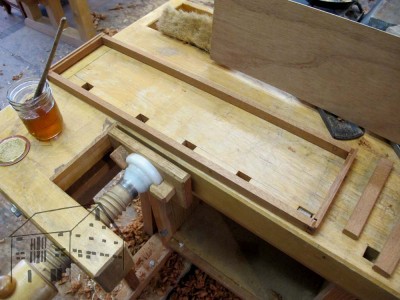
and finally all glued together with hot hide glue. I simply glued the 1/8″ plywood bottom to the sides and the underside of the rabet on the front.

The weather projections became increasingly dire, and given my very tight travel schedule for this week, I could not afford to get snowed in and so we bugged out by lunch time on Sunday to beat the storm. Good thing we did as this is the scene on waking this morning. Up in the mountains they had even more snow, perhaps four or five more inches.
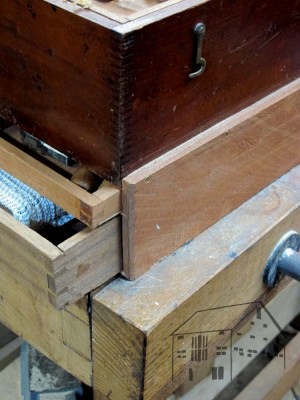
Down in the basement I finished fitting the new drawer so now it is ready to fulfill its task. Which is, to paraphrase philosopher Dolly Parton when commenting on the failure of a sequined gown to contain her, uh, self, “packing thirty pounds of mud in a twenty pound bag.” My goal is to outfit the box as my traveling kit with enough to do about 95% of everything that needs to be done in simple furniture making.
The middle two weekends of March are the time of the annual Highland Maple Festival in Highland County, Virginia, the least populous county east of the Mississippi (2200), the highest average elevation county (3000′) east of the Mississippi, and the southernmost outpost of maple syrup production in North America. Over the years it has grown to where now tens of thousands of visitors come each of the two weekends, joining the residents in a rollicking good time of maple pancakes, maple donuts, shopping at scores of food and craft vendors, and milling about.

Normally in Monterey VA you could practically fall asleep in the middle of Main Street without much risk of bodily harm, but last Saturday, a beautiful warm and sunny day after a brutal winter (there had been 9 inches of snow the preceding Monday) there was a several mile back-up on each of the four routes into the town of 180 residents.
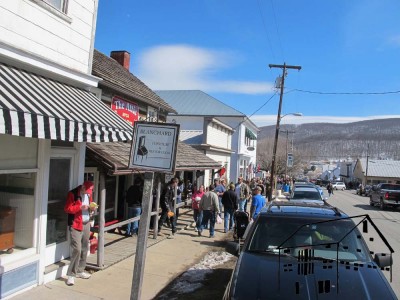
As is my custom I joined David Blanchard in his Main Street shop demonstrating hand tool woodworking. This year I decided to finally build some real doors for my barn workshop.

After ripping by hand some 6″ x 5/4 southern yellow pine I planed it true for the door stiles.
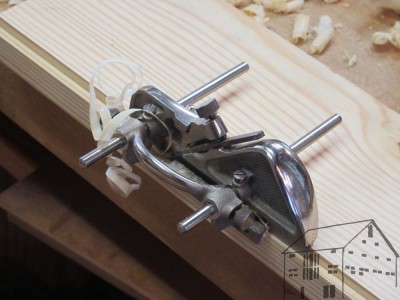
Since it was going to be double glazed, befitting its function as the barrier between the inside (heated) space of my workshop and the barn-side (unheated) space, I shot a pair of rabbets along both the front and rear inner edges of the frame, where I will add the glazing.
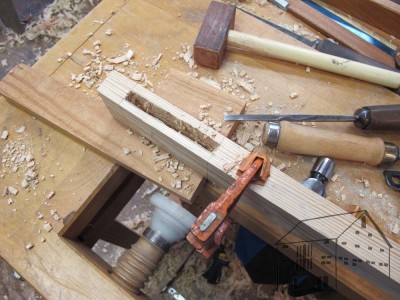
Then I cut the tenons and chopped the mortises for the rails to fit into the stiles.
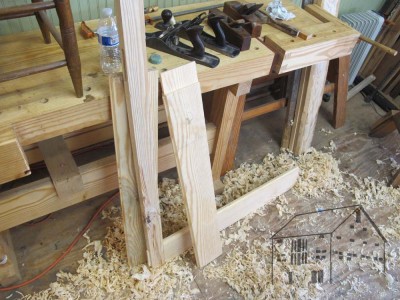
This is how far I got between chatting with the hundreds of folks who ventured in. I hope to return to the project this coming weekend, but the truth is I must have done something to my shoulder shoveling that recent snowfall so it remains to be seen if I can do work this heavy this soon. If not, I will do something smaller, like making a new drawer for my travelling tool box or perhaps making a new toothing plane.
Last weekend was especially blessed as we were visited by our older daughter, bearing some slightly tardy birthday gifts — SPAM and ammo! Brings a tear to an old man’s eyes, I tell you.
In the year before I retired, I sponsored a several-months-long visit by my long-time friend Juliane Derry who came from her home in Norway to spend several months at the Smithsonian’s Museum Conservation Institute to conduct research and analysis in support of her Master’s Degree in conservation from the university of Oslo. Having made two in-person treks to India to gather samples herself, she had a wide range of vouchered specimens to analyze at MCI’s state of the art facility.
Juliane titled her Thesis “Investigating Shellac: Documenting the Process, Defining the Product. A study on the processing methods of Shellac, and the analysis of selected physical and chemical characteristics.”
It may be the most important technical work on shellac of our generation.
Today was a crisp clear day in the Mid-Atlantic. Whether it is the “calm before the storm” or the “calm before the slush” remains to be seen, as will be revealed over the next 48 hours.
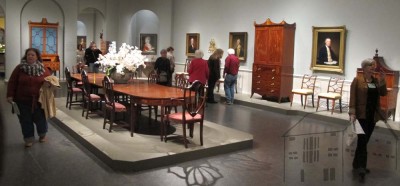
One of our SAPFM Chesapeake Chapter (thanks Jonathan!) organized an informal gathering at the National Gallery for a gallery walkabout through the Kaufman Collection, probably the best easily-available-to-the-public exhibition of historic furniture in DC.
After first gathering at the Cafe next to the skating rink in the NGA Scultpure Garden, where we had a rollicking good time of swapping tales, we headed over to the Gallery.

I’ve been to the exhibit several times before, and am still struck by the amazing scagliola (inlaid marble) featured on this table at the beginning of the exhibit.
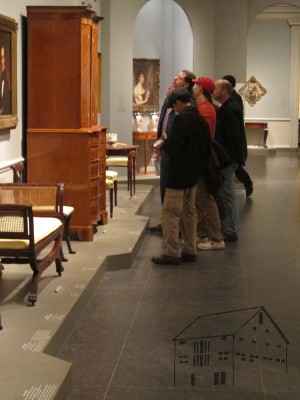
It wasn’t long before clusters of folks formed and flowed looking at the amazing furniture of those makers who went before us.

I find myself increasingly attracted to more restrained forms. I can appreciate the ornate and opulent — I am working on the Roubo project after all, and what is more outlandish than some French marquetry? — but the understated expression of some Federal pieces is particularly strong in my eyes.
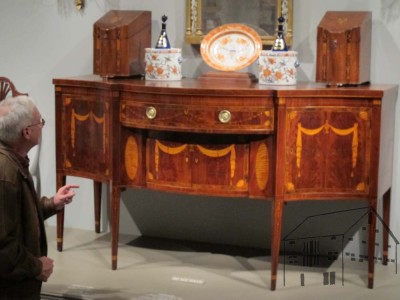
Just before we left the exhibit, Dan asked me about some of the detailing on this over-the-top Federal sideboard. Fortunately I had already covered that ground for my friend Betsy Davison’s book on the idiosyncratic furniture maker John Shearer (it’s a great book; buy it!). The feature in question was some incised and punched detailing on the marquetry, with the incising filled with either asphaltum or pitch to provide the black line accents.
I was delighted to see that Tod Herrli‘s new video on making an ogee molding plane is ready to debut. I made sure to get my pre-release order in so that it could come as soon as possible. I have long held sincerely that Tod’s first video on making a hollow-and-round pair of planes was perhaps the finest instructional video I have ever seen on any topic.
Just a reminder, Tod will be teaching two workshops at The Barn this coming August 11-17. Drop me a line at info@donsbarn.com if your are interested in joining us.
















































Recent Comments